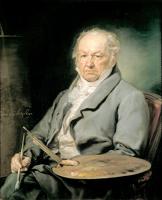Francisco de Goya
 |
A famed painter in his own lifetime, Francisco de Goya was born on March 30, 1746, in Fuendetodos, Spain. He began his art studies as a teenager and even spent time in Rome, Italy, to advance his skills. In 1770s, Goya began to work for Spanish royal court. In addition to his commissioned portraits of the nobility, he created works that criticized the social and political problems of his era.
He was a student of José Luzán Martínez. At first, Goya learned by imitation. He copied the works of great masters, finding inspiration in the works of such artists as Diego Rodríguez de Silva y Velázquez and Rembrandt van Rijn.
Through the German artist Anton Raphael Mengs, Goya started to create works for Spain's royal family. He first painted tapestry cartoons, which were artworks that served as models for woven tapestries, for a factory in Madrid. These works featured scenes from everyday life. He continued to rise in status, receiving admission into the Royal Academy of San Fernando the following year. Goya began to establish a reputation as a portrait artist, winning commissions from many in royal circles. He skillfully captured the tiniest elements of their faces and clothes.
Despite his poor health, Goya thought he might be safer outside of Spain. Goya moved to Bordeaux, France, where he spent the remainder of his life. During this time, he continued to paint. Some of his later works included portraits of friends also living in exile. Goya died on April 16, 1828, in Bordeaux, France.